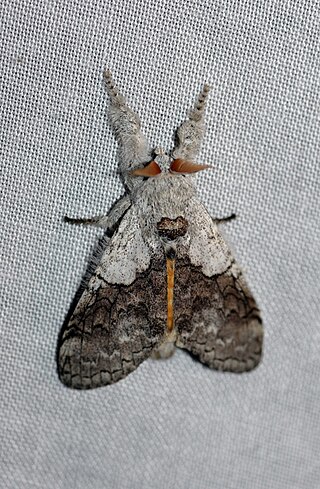
The Chavez Ravine Arboretum, in Elysian Park, just north of Dodger Stadium, at 929 Academy Road, Los Angeles, California, contains more than 100 varieties of trees from around the world, including what are believed to be the oldest and largest Cape Chestnut, Kauri, and Tipu trees in the United States. Admission to the arboretum is free.

Schinus terebinthifolia is a species of flowering plant in the cashew family, Anacardiaceae, that is native to subtropical and tropical South America. Common names include Brazilian peppertree, aroeira, rose pepper, broadleaved pepper tree, wilelaiki, Christmasberry tree and Florida holly. The species name has been very commonly misspelled as ‘terebinthifolius’.

Mimallonidae Burmeister (mimallonids), sometimes known as "sack-bearer" moths for the larval case-building behavior, are a family of Lepidoptera containing over 300 named species in 43 genera. These moths are found only in the New World, with most taxa occurring in the Neotropics. Adult moths are externally similar to those belonging to some of the other Macroheterocera families Bombycoidea and Drepanoidea, and thus have been variously treated as belonging to either one of these or other superfamilies.
Miconia is a genus of flowering plants in the glory bush family, Melastomataceae, native to warm temperate to tropical regions of the Americas. The species are mostly shrubs and small to medium-sized trees up to 15 m tall. The generic name honours Catalan physician and botanist Francesc Micó. Some species are known by the common name johnnyberry.
Miconia calvescens, the velvet tree, miconia, or bush currant, is a species of flowering plant in the family Melastomataceae. It is native to Mexico and Central and South America and it has become one of the world's most invasive species.

Psidium cattleyanum , commonly known as Cattley guava, strawberry guava or cherry guava, is a small tree in the Myrtaceae (myrtle) family. The species is named in honour of English horticulturist William Cattley. Its genus name Psidium comes from the Latin psidion, or "armlet." The red-fruited variety, P. cattleyanum var. cattleyanum, is commonly known as purple guava, red cattley guava, red strawberry guava and red cherry guava. The yellow-fruited variety, P. cattleyanum var. littorale is variously known as yellow cattley guava, yellow strawberry guava, yellow cherry guava, lemon guava and in Hawaii as waiawī. Although P. cattleyanum has select economic uses, it is considered the most invasive plant in Hawaii.

Andropogon virginicus is a species of grass known by several common names, including broomsedge bluestem, yellowsedge bluestem and whiskey grass. It is native to the southeastern United States and as far north as the Great Lakes. It is known as an introduced species in California and Hawaii, where it is weedy.

Anacamptodes fragilaria, the kiawe moth, koa haole looper or citrus looper, is a species of moth in the family Geometridae. The species was first described by John Arthur Grossbeck in 1909. It is found in the Hawaiian islands of Kauai, Niihau, Oahu, Molokai, Maui and Hawaii as well as California, where it is native.
Euphorbia deppeana is a rare species of flowering plant in the family Euphorbiaceae known by the common names Deppe's broomspurge and Oahu sandmat. It is endemic to Oʻahu, Hawaii, where it is known from only one population in moist shrublands on Nuʻuanu Pali. Like other native Hawaiian euphorbs it is called ʻakoko locally.
Schiedea kauaiensis is a rare species of flowering plant in the family Caryophyllaceae known by the common name Kauai schiedea. It is endemic to Hawaii, where it is known only from the island of Kauai. It is threatened by the degradation and destruction of its habitat. It was federally listed as an endangered species of the United States in 1996.
This is an alphabetical list of useful timber trees, indigenous and exotic, growing in the Gauteng area of South Africa. These trees range in size up to some 1.5m DBH, such as Cedrus deodara, the Himalayan Cedar. Hobbyists will seek out even small pieces of highly valued timber, such as Buxus macowanii, the South African counterpart of Buxus sempervirens, for turnery or the making of boxes and small items. Despite the wealth of useful woods available in Gauteng, most of the trees, felled or fallen, are dumped or cut into short lengths for fuel. Trees grown in urban or suburban environments are rarely pruned and are consequently often knotty. Timber frequently holds nails, wire and spikes, attesting to a variety of abuse during the lifetime of a tree, and requiring the use of a metal detector by the sawmiller. Garden cuttings and dead leaves are occasionally piled next to trees and burnt, leaving charred scars and inclusions.

Calliteara horsfieldii, or Horsfield's tussock moth, is a moth of the family Erebidae. The species was first described by the British entomologist Edward Saunders in 1851, and named in honor of the British naturalist Thomas Horsfield, who traveled southern Asia and published works on zoology from the region. C. horsfieldii can be found in southern Asia, the islands of the northern Indian Ocean, and many parts of south east Asia and Indonesia. It is also sometimes referred to as the Yellow Tussock Moth.
Drosophila musaphilia is an endangered species of fly from Hawaii, in the species rich lineage of Hawaiian Drosophilidae. It is only found on the island of Kauai. The last reported sighting of this species was in 1988.